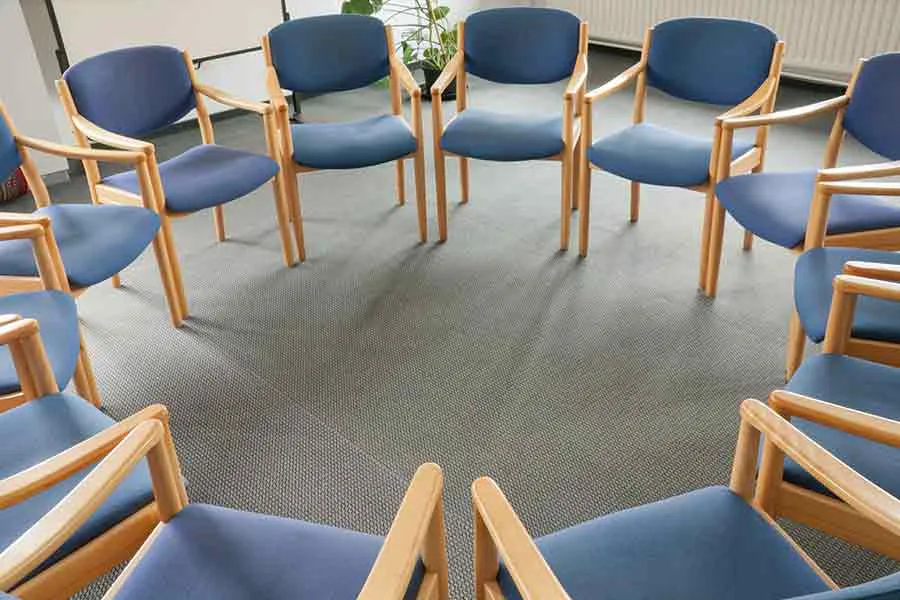What is group therapy used for?
Group therapy is used to guide clients through the process of gaining insight about themselves, others, and the world around them.
Through the group dynamic, clients foster hope and examine core issues that exacerbate their addictive disorders. They also work to develop their communication skills and learn to engage in fun, healthy social experiences. The group dynamic encourages honest feedback and facilitates bonding between individuals with shared experiences. Clients weigh in on the issues of others in order to offer suggestions or provide outside perspectives, broadening the individual’s understanding of the conflict.
Other goals of group therapy include gaining inspiration through the recovery of others, self-identifying as a recovering addicting, and examining core values. Participants support and nurture each other like a family by reinforcing good behaviors and helping each other cope during difficult tasks. These groups further encourage exploration of emotional and interpersonal conflicts, confrontation about denial and harmful behaviors, and discussion about responsibilities and limitations. They add structure to chaotic lives and provide a safe environment in which to practice newly developed skills.
Who leads group therapy?
Groups are lead by a trained group leader who prompts discussion and encourages everyone to participate. Other than gently guiding conversation, the group leader is responsible for picking up on client issues that reoccur in group therapy and in daily life. Clients will oftentimes subconsciously demonstrate actions in group therapy that are representative of their routine patterns and thought processes. For example, clients who are “people-pleasers” might exemplify this by constantly validating the comments of others while keeping their own stories to themselves in order to avoid potentially causing conflict. These instances serve as opportunities for the group leader to make suggestions and to give the client insight into habits that might need alteration. Observing individuals in this group dynamic gives therapists a different perspective that allows them to enhance the quality of care provided for clients.
How does Two Dreams use group therapy in addiction treatment?
The program here at Two Dreams focuses on the improvement of one’s life through the achievement of mental peace, physical well-being, and personal productivity. We particularly emphasize mindfulness, the concept of intentionally paying attention, and being present in the moment with compassion, with acceptance, and without judgment. Every two weeks our clients engage in “group phase therapy” in which each individual reports on which phase they think they’re currently working on in their personal recovery journey. The rest of the group comments on the accuracy of their assessment and gives advice.
Two Dreams defines recovery as happening in three phases: “Coming In”, “Looking In”, and “Looking Out.” During the “Coming In” phase, clients establish a trusted support system of peers and staff members. They develop healthy rituals and the self-confidence needed to honestly share their addiction stories. During the “Looking In” phase, clients learn to honor thoughts, feelings, and aspirations. By being transparent and exposing negative core beliefs, clients begin the process of forming a healthier sense of self. Transparency and introspection lead clients to find some of the deeper issues fueling their addiction. They learn to act intentionally instead of reacting automatically to stimuli. They learn to analyze the thoughts and feelings behind their actions. They learn to acknowledge their addiction and reduce incentives to use in the future. In the “Looking Out” phase, clients have the tools needed to succeed and develop lifelong healthy habits. They can work on creating a plan for the long-term future, designed to manage cravings, relationships, etc.
Does Two Dreams use process or theme groups?
Two Dreams utilizes process groups as opposed to theme/support groups. Process groups are focused on self-exploration and giving/receiving feedback. They provide a safe environment in which members can practice newfound interpersonal skills and behaviors. Process groups are mostly unstructured with no singular topic of discussion. Theme groups are focused on support and finding commonalities between members. They tend to have more structure than process groups and focus on a single topic. Two Dreams prefers to hold process groups in order to enhance the holistic treatment experience and to help clients equip themselves with the tools needed for their own recovery.
A list of possible group therapy activities
The first time attending any group therapy session can be intimidating. We find that many of our clients are unsure of what to expect, and need time to feel out the group dynamic before speaking up.
This is completely natural, and you are not alone if you are uncomfortable sharing in front of a group. Going in with some idea of what to expect can help you focus on your recovery instead of on your nerves, so here are 60 substance abuse group therapy activities and topics you might encounter during your experience during a theme/support group:
- Identify and discuss triggers for substance use. What kinds of coping strategies can you use to overcome your triggers? Can you identify any patterns?
- Discuss gratitude. What is gratitude? What are you grateful for and why?
- Discuss the impact of language. How do certain words influence our thoughts and actions? Why are some words considered “bad” and others “good?” Are there any words that you strongly associate with substance use? How can you use your word choices to harm or support others? How can you use your word choices to harm or support yourself?
- Make a list of activities to do instead of using drugs. What can you do when you’re faced with cravings? What can you do to prevent cravings in the first place?
- Write in stream of consciousness form for a period of time. Write down whatever comes to mind, even if it’s “I can’t think of anything to write;” just put pencil to paper and see what emerges. Everyone has the opportunity to share his or her writing when the time is up.
- Make a list of the best moments in your life. Make a list of the worst moments of your life. What made them good or bad? Can you identify any patterns or similarities between the events?
- What words would you use to describe yourself? What words would others use to describe you? What words would you use to describe an ideal person? How and why do these descriptions differ?
- Play charades; practice expressing yourself without speaking. Discuss the importance of body language.
- Participate in a role-playing mock interview. Play the role of someone who has been affected by your substance use (ex. a mother, a daughter, a friend, etc.) Others in the group will ask questions and you should answer in character. Discuss the importance of empathy and “walking a mile in someone else’s shoes.”
- Discuss the importance of nutrition. What are your nutrition goals? What are you currently doing to achieve these goals? What can you do in the future? What should you stop doing? Would you say you have a healthy relationship with food? Why or why not?
- Discuss the importance of physical fitness. What are your fitness goals? What are you currently doing to achieve these goals? What can you do in the future? What should you stop doing? Would you say you currently have a healthy fitness regimen? Why or why not?
- Discuss the importance of sleep. What are your sleep goals? What are you currently doing to achieve these goals? What can you do in the future? What should you stop doing? Would you say you currently have a healthy sleep regimen? Why or why not?
- Discuss the importance of self-care. What are your self-care goals? What are you currently doing to achieve these goals? What can you do in the future? What should you stop doing? Would you say you currently have a healthy self-care regimen? Why or why not?
- Make a list of your bad habits. What makes them bad? What can you do instead when you are tempted to engage in the habit? Discuss ways to replace the bad habits with healthier ones.
- Practice anger management skills. What makes you angry? What can you do to prevent getting angry? What can you do to keep your anger under control?
- Discuss forgiveness. Is there anyone in your life that you would like to forgive? What would you say to them in that scenario? What would you like them to know? How would you like them to respond?
- Learn about and discuss the effects of opioids.
- Take turns playing an instrument that can be passed around the group, such as the Tibetan singing bowl.
- Create a group story word by word. Everyone should sit in a circle and contribute one word to the story during their turn. For example, the first person might say “birds,” and the second might say “flew,” and the third might say “by,” and the fourth might say “my,” and the fifth might say “window,” etc.
- Share a song with the group that has real meaning for you and explain why. Listen to the meaningful songs that others bring to the group and appreciate that everyone derives inspiration from different sources.
- Practice meditation: close your eyes, breathe deeply, and try to clear your mind.
- Tense up all of your muscles then progressively relax them. Discuss the impact of stress and the importance of letting it go.
- Take turns sharing a personal, emotional story. The others in the group should try to identify the emotions you felt. Discuss the difficulty of identifying emotions, both personally and externally.
- Create a group scene through imagination. Pick a location and ask each individual to describe a different element of the scene to make it more visible to everyone. For example, if the scene takes place in a park then one person might say they can smell cut grass, and another might say they can see children playing on a swing set, and another might say they can taste mint chocolate chip ice cream, etc.
- Discuss where you think you are in your recovery journey. Talk about what you’ve accomplished and what you would like to accomplish in the future. Ask everyone else what he or she thinks you’ve accomplished and what they would like to see you accomplish in the future.
- Learn about and discuss the neuroscience of addiction.
- Work through the famous trolley thought experiment as a group: in short, would you pull a lever that would save the lives of five people on a runaway train if it meant that you would be responsible for diverting the train onto another track on which it would run over one person? This prompts discussion of morals and ethics while encouraging people to think critically and voice their opinions in a constructive manner.
- Everyone should anonymously write a fear on a piece of paper and put it into a bowl. The bowl should then be passed around the group and each individual should draw a piece of paper and talk about the fear they selected. How do you think the person who wrote on that piece of paper developed their fear? Do you share the same fear? Can you think of any ways to conquer that fear or turn it into something constructive? Do this exercise with other emotions and scenarios as well to further practice empathy.
- The group leader should write different labels on nametags and stick one on the back of each individual. Labels can include things like addict, criminal, arrogant, depressed, liar, rich, poor, sick, stupid, etc. Then everyone should walk around the room treating each other according to their label. Each person has to figure out what their label says by the way that people are treating them. This is a great way to examine stereotypes and treatment of others.
- Learn about and discuss the effects of alcohol.
- Imagine an anonymous donor gave you a billion dollars. How would you spend it and why?
- What advice would you give to your childhood self? Would you do anything differently if you could go back and do it all over again?
- Have you ever been bullied? Have you ever bullied anyone? What actions can you take to stop bullying if you see it? What actions can you take to remove yourself from harm’s way if needed?
- Role-playing exercise: one person pretend to peer pressure the other into using drugs. The other person should practice resisting the peer-pressure. What can you say in response? What actions can you take? Can you think of any ways to control your cravings on the spot?
- When you were younger, how would you answer the question “what do you want to be when you grow up?” How would you answer that question now? How do the answers differ and why? Are you satisfied with who you are and what you do now?
- Discuss stress-management. What makes you stressed? Does stress have a purpose? What actions can you take to control your stress? What happens when you don’t control your stress?
- Identify the support systems in your life, internal and external. What do they do to support you? What else could they do to support you? Who are you a support system for? What else can you do to support others? How do your peers in group therapy act as a support system for you? Are you also willing to be a support system for them?
- Discuss dual-diagnosis. Discuss how substance use makes mental illness worse and vice versa. Identify patterns and connections between the two in your own life. Do you think that treating the diagnoses simultaneously is the most effective course of action? Why or why not?
- Discuss 12-step programs. What are the pros and cons? Will you continue to attend 12-step meetings after discharge? Why do you think they have helped so many people? Do you think that all of the steps are relevant in today’s society?
- Everyone should go around and share a personal experience related to depression. The others in the group should then respond with feedback and advice. This is a simple way to show support for fellow group members and to strengthen bonds through common experiences. It is also a way to give and receive tips for future success and to feel relief knowing that others are struggling as well. Go through this exercise with other experiences as well, for example times of hopelessness, temptation, anger, etc.
- Discuss the consequences of breaking abstinence after treatment. What’s the best thing that could happen from using drugs again? What’s the worst? Make a list of reasons to never use again.
- Discuss your role models. Who are your heroes? Have your heroes changed throughout your life? What have they done to inspire you? What traits do you wish to emulate? Do your heroes have faults as well? How can you use their behavior to motivate you on your recovery journey healthy?
- Discuss mindfulness and living in the moment. What things must you accept that you cannot change? What are the benefits of living in the present? Brainstorm mindfulness mantras.
- Write a list of self-affirmations. Brainstorm affirmations for others in the group. What makes you uniquely you? Why is comparing yourself to others a useless task?
- Learn about and discuss the effects of smoking tobacco.
- Read uplifting books or passages about addiction, mindfulness, living a healthy life, and other positive topics.
- Engage in aromatherapy. Light scented candles or incense around the room, or use a diffuser with essential oils. Appreciate the sensation of smell and try to focus on the present moment.
- Write about or describe any scene using all five senses to stimulate sensory awareness and to encourage attention to detail.
- Introduce yourself to the group by telling everyone three funny or weird things about yourself. The others in the group should do the same.
- Two individuals should stand in front of the rest of the group and the group leader should call out a conflict scenario for them to act out. For example, the scenario could be that one guy is screaming at another for stealing his girlfriend and the two are about to get into a fistfight. After the actors act out the scene, the rest of the group should suggest ways that the situation could be handled more appropriately. After discussion, the two actors should act out the scene again, this time practicing appropriate conflict resolution.
- The group leader should ask everyone in the group to think of themselves in abstract terms and raise their hands when they hear the option to which they most relate. Examples include hammer or nail, rubber ball or silly putty, dictionary or novel, egg white or egg yolk, etc. Discuss the reasoning behind each answer and compare with the rest of the group. Look for patterns in your own answers.
- Discuss the concept of the “locus of control,” ie. whether or not the consequences of our actions are within our control. Compare the pros and cons of both extreme ways of thinking.
- Play with optical illusions and brain trickery exercises. Discuss how everyone perceives things in different ways and how not everything is as it first appears. Discuss the fallibility of the human mind.
- Imagine that it’s your last day on earth. What would you do? Who would you spend it with? Would you be satisfied with the way your life turned out? If not, what do you wish you had done? What would people say about you at your funeral?
- Learn about and discuss the effects of marijuana.
- Share a childhood memory. Would you say you had a satisfying childhood? If you have children, would you raise them in the same way you were raised? Why or why not? What would you change or add?
- Write out a timeline of your life including any events of your choosing. Compare timelines with others in the group. Why did you choose those particular events to include in your timeline? Is the timeline divided into stages or milestones? Is there a center event? Are any periods of time particularly crowded or blank? Do you see any patterns? What will your future timeline look like? Do you wish you could make any changes to your past timeline?
- Brainstorm ways to reduce isolation. Discuss isolation risks and benefits, and how to identify how much alone time is too much.
- Pretend like you’re speaking at a drug abstinence seminar for high school students. What would you tell them? What stories would you share? What advice do you have to give?
- If you could tell the whole world just one thing, what would it be and why?
Sharing
If you liked this list, please feel free to share it or link to it! Also, please leave a comment below if you have other ideas, or would like to add to the discussion.
We have made this list available here: 60 Substance Abuse Group Therapy Activities PDF – please feel free to download it, print it, share it, and post it on your own website!
We also have a list of 60 MORE Substance Abuse Group Therapy Activities. Check it out for more useful group therapy ideas!
Sources Cited:
http://www.ncbi.nlm.nih.gov/books/NBK64223/
http://hubpages.com/health/Group-Topics-for-the-Mentally-Ill
http://www.purposefulbliss.com/post-it-note-group-therapy-activities/





